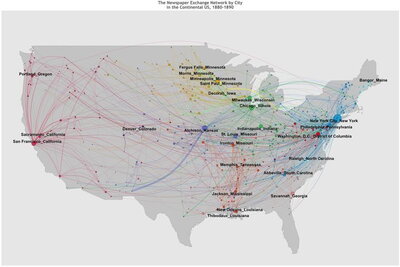
A project to examine the circulation of newspaper reports about anti-Black violence in nineteenth- and early twentieth-century U.S. newspapers could provide context to the spread of white supremacist ideologies in social media today. "The Virality of Racial Terror in US Newspapers, 1863-1921" (VRT) is a partnership between the University of Illinois Urbana-Champaign, Northeastern University, and Washington University, with Illinois serving as the lead institution. VRT was recently awarded a $500,000 grant from the Mellon Foundation, as part of its Higher Learning program that supports inquiry into issues of vital social, cultural, and historical import.
The principal investigator at Illinois will be Ryan Cordell, associate professor in English and the School of Information Sciences, who also co-leads Viral Texts, a project that examines the way in which information moved around the country and world through newspapers during the nineteenth century. According to Cordell, most of the newspapers at that time were predominately reprinted text, and the most "viral" pieces in a newspaper—items that readers were most excited about—were reprinted and circulated in other newspapers.
The VRT project will focus on eight case studies of anti-Black violence spanning from the 1860s to the 1920s. The team will draw on the Viral Texts project's computational methods for reprint identification to trace how stories related to these case studies spread around the country, how the texts were edited for different audiences, and the emergence of new stories in response. The project will expand the work being done by the Racial Violence Archive project at Washington University to document and map the spread of violent events by examining large-scale collections of digitized newspapers.
"We submitted our initial concept paper [for the VRT project] only days after a white supremacist terrorist live-streamed his massacre of Black Americans in a Buffalo supermarket, seeking to spark a cascade of racial violence," said Cordell. "Such attempts to spur 'copy cat' violence through social media in 2022 mirror the dynamics of racial terror that VRT will trace in the late nineteenth and early-twentieth centuries."

According to the project team, while VRT will use the case studies to focus on anti-Black violence in the past, the methods can serve as a model for future research into violence against other racial, ethnic, or identity communities, both historically and up to the present.
Cordell's research areas include book history, book arts, print culture, bibliography, digital humanities, text and data mining, machine learning, and critical making. Cordell directs the Skeuomorph Press & BookLab in the Champaign-Urbana Community FabLab and is a Senior Fellow in the Andrew W. Mellon Society of Critical Bibliography at the Rare Book School. He earned his PhD in English language and literature from the University of Virginia.
Article reprinted from the iSchool.